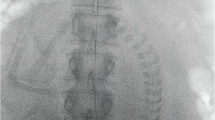Abstract
Purpose
To investigate safety and efficacy of intra-aortic balloon occlusion (IABO) versus internal iliac artery balloon occlusion (IIABO) for cesarean delivery in coexisting placenta accreta and placenta previa.
Materials and Methods
From 2006 to 2019, 60 pregnant women who had undergone preoperative IABO (n = 28) and IIABO (n = 32) for cesarean delivery in coexisting placenta accreta and placenta previa were retrospectively identified, and their medical records and relevant imaging were reviewed.
Results
Maternal characteristics (age, gravidity, previous cesarean delivery, gestational age, and neonatal weight) were similar in both groups. Estimated blood loss, volume of blood transfusion, length of hospitalization, and rate of hysterectomy were not significantly different between the groups. Operation time (the duration of cesarean delivery and hysterectomy, p < 0.05), total time of balloon occlusion (p < 0.01), and fetal radiation dose (p < 0.001) in the IABO group were less than in the IIABO group. No severe complications related to the balloon occlusion procedure were noted in either group.
Conclusion
IABO and IIABO are safe and effective options for cesarean delivery in patients with combined placenta accreta and placenta previa. The average operation time, balloon occlusion time, and fetal radiation dose in patients with IABO are less than in patients with IIABO. There were no complications related to balloon occlusion of the aorta or internal iliac artery.


Similar content being viewed by others
References
Matalliotakis M, Velegrakis A, Goulielmos GN, Niraki E, Patelarou AE, Matalliotakis I. Association of Placenta Previa with a History of Previous Cesarean Deliveries and Indications for a Possible Role of a Genetic Component. Balkan J Med Genet. 2017;29, 20(2):5–10.
Fan Y, Gong X, Wang N, Mu K, Feng L, Qiao F, Chen S, Zeng W, Liu H, Wu Y, Zhou Q, Tian Y, Li Q, Yang M, Li F, He M, Beejadhursing R, Deng D. A prospective observational study evaluating the efficacy of prophylactic internal iliac artery balloon catheterization in the management of placenta previa-accreta: A STROBE compliant article. Medicine. 2017;96(45):e8276.
Goh WA, Zalud I. Placenta accreta: diagnosis, management and the molecular biology of the morbidly adherent placenta. J Matern Fetal Neonatal Med. 2016;29(11):1795–800.
Wang YL, Duan XH, Han XW, Wang L, Zhao XL, Chen ZM, Chu QJ, Zhang W. Comparison of temporary abdominal aortic occlusion with internal iliac artery occlusion for patients with placenta accreta—a non-randomised prospective study. Vasa. 2017;46(1):53–7.
Li K, Zou Y, Sun J, Wen H. Prophylactic balloon occlusion of internal iliac arteries, common iliac arteries and infrarenal abdominal aorta in pregnancies complicated by placenta accreta: a retrospective cohort study. Eur Radiol. 2018;28(12):4959–67.
Wei Y, Luo J, Luo D. Comparison of Efficacy between Internal Iliac Artery and Abdominal Aorta Balloon Occlusions in Pernicious Placenta Previa Patients with Placenta Accrete. Gynecol Obstet Invest. 2019;84(4):343–9.
Mei Y, Zhao H, Zhou H, Jing H, Lin Y. Comparison of infrarenal aortic balloon occlusion with internal iliac artery balloon occlusion for patients with placenta accreta. BMC Pregnancy Childbirth. 2019;2, 19(1):147.
Xie L, Wang Y, Luo FY, Man YC, Zhao XL. Prophylactic use of an infrarenal abdominal aorta balloon catheter in pregnancies complicated by placenta accreta. J Obstet Gynaecol. 2017;37(5):557–61.
Sun W, Duan S, Xin G, Xiao J, Hong F, Hong H, Wu Y, Xu Y. Safety and efficacy of preoperative abdominal Aortic balloon occlusion in placenta increta and/or percreta. J Surg Res. 2018;222:75–84.
Zamzami TY. Maternal and perinatal outcome of massive postpartum hemorrhage: a review of 33 cases. Ann Saudi Med. 2003;23(3–4):135–9.
Chen L, Wang X, Wang H, Li Q, Shan N, Qi H. Clinical evaluation of prophylactic abdominal aortic balloon occlusion in patients with placenta accreta: a systematic review and meta-analysis. BMC Pregnancy Childbirth. 2019;15, 19(1):30.
Wei X, Zhang J, Chu Q, Du Y, Xing N, Xu X, Zhou Y, Zhang W. Prophylactic abdominal aorta balloon occlusion during caesarean delivery: a retrospective case series. Int J Obstet Anesth. 2016;27:3–8.
The 2007 Recommendations of the International Commission on Radiological Protection. ICRP publication 103[J]. Ann ICRP, 2007, 37(2-4): 1–332
Qasim Z, Brenner M, Menaker J, Scalea T. Resuscitative endovascular balloon occlusion of the aorta. Resuscitation. 2015;96:275–9.
Peng ZH, Xiong Z, Zhao BS, Zhang GB, Song W, Tao LX, Zhang XZ. Prophylactic abdominal aortic balloon occlusion: An effective method of controlling hemorrhage in patients with placenta previa or accreta. Exp Ther Med. 2019;17(2):1492–6.
Buckley B. Interventional radiology in abnormal placentation. Obstet Gynecol Mag. 2010;12:57.
Funding
The authors received no financial support for the research, authorship, and/or publication of this article.
Author information
Authors and Affiliations
Contributions
All authors provided clinical expertise and participated in drafting the manuscript. All authors read and approved the final manuscript.
Corresponding author
Ethics declarations
Conflict of interest
The authors declare that they have no competing interests.
Ethical Approval
Written informed consent was obtained from all patients and residents participating in the study, as approved by the ethics committee of our hospital.
Consent for Publication
Written informed consent for publication was obtained from all patients and residents participating in the study.
Additional information
Publisher's Note
Springer Nature remains neutral with regard to jurisdictional claims in published maps and institutional affiliations.
Rights and permissions
About this article
Cite this article
Tokue, H., Tokue, A., Tsushima, Y. et al. Safety and Efficacy of Aortic Vs Internal Iliac Balloon Occlusion for Cesarean Delivery in Coexisting Placenta Accreta and Placenta Previa. Cardiovasc Intervent Radiol 43, 1277–1284 (2020). https://doi.org/10.1007/s00270-020-02548-9
Received:
Accepted:
Published:
Issue Date:
DOI: https://doi.org/10.1007/s00270-020-02548-9




